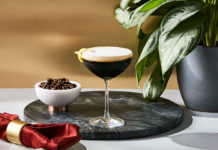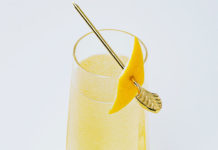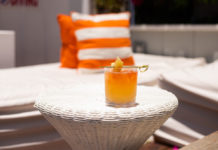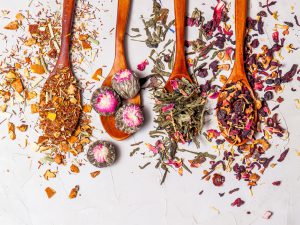 When the craft cocktail zeitgeist began overtaking the pour-and-serve approach in popularity among increasingly adventurous customers a few years ago, creative cocktail menus from coast to coast revealed that fruits, vegetables, and herbs were not the only elements ripe for the picking. Tea infusions started turning up in some bartenders’ tool kits, exponentially expanding the palettes of flavor profiles they could invent or reinvent, while expanding customers’ palates in the process.
When the craft cocktail zeitgeist began overtaking the pour-and-serve approach in popularity among increasingly adventurous customers a few years ago, creative cocktail menus from coast to coast revealed that fruits, vegetables, and herbs were not the only elements ripe for the picking. Tea infusions started turning up in some bartenders’ tool kits, exponentially expanding the palettes of flavor profiles they could invent or reinvent, while expanding customers’ palates in the process.
Other bartenders who have worked with tea for years point out that tea has long been a remedy for an otherwise dull cocktail menu thanks to the many varietals on the market.
“Ten to fifteen years ago, all we were talking about was infusions,” says Brian McDougall at Outlook Kitchen and Bar at The Envoy Hotel in Boston, who has been working with teas for over ten years.
His first tea infusion cocktail was a gin cocktail infused with lemongrass and chamomile. “If something wasn’t bolted down, it was being put into a bottle or container to infuse. Moving into the craft/prohibition era was a refreshing revolution, as it took bartending back to the fundamentals and pushed many cocktail programs to sink or swim. Tea infusing has the ability to bring together new and old. Tea can link the culinary world and the cocktail world, which seems to be trending faster than anything right now,” says McDougall. “Furthermore, tea infusing is an excellent way to tighten your margins and still deliver a high-quality product. Using a lesser-known, more reasonably priced spirit and introducing an elegant tea such as hibiscus is an efficient way to elevate and optimize your final product.”
McDougall says that vodka, being a neutral spirit, picks up the most uninterrupted flavor from any tea and that clear spirits generally have a faster steep time. Whereas spirits like rum, whiskey, and tequila have a more robust flavor profile, and therefore require a longer steep to express the tea. “Timing is the best part,” he says. “It gives you the freedom to create your own style of infusion.”
McDougall finds that green teas work well with gin while chamomile, hibiscus, and chai compliment rums, whiskeys, and tequilas best.
Enthusiasm continues to brew for an increased presence of teas (and their herbal cousins) in cocktail lists. Differentiation between bartenders and their venues can be achieved when a well chosen tea is infused carefully into a spirit with harmonious flavor notes.
“Teas provide an easy way to add extra complexity to an individual cocktail or a whole menu,” says Mixologist Freddie Sarkis of Upstairs at The Gwen located in Chicago’s The Gwen, a Luxury Collection Hotel, who has embraced tea in his bartending practice over the past 15 years.
Sarkis stresses everything a bartender does behind the bar is some form of infusion or emulsification. “It also has a seasonal element where you will want to use light, fragrant herbals in the spring and summer and deeper, more intense black teas in the fall or winter—as we do with spirits. [However], you need to figure out when developing your recipe if you want the addition of tea to have a deep, intense tannic note, or provide more of a delicate note to the overall flavor profile,” he says. “If you want a tannic flavor profile and structure, infuse a spirit longer and with heat. If you want a subtle flavor, infuse spirits with tea for a shorter period of time and without heat.”
Although Sarkis agrees with the notion that certain teas may be harmonious with certain spirits, it should never limit a bartender’s drive to experiment with different flavor combinations. Nevertheless, he does caution that some spirits can overpower teas while other teas will overwhelm some of a spirit’s distinctive notes.
“Green teas can be delicate or strong and tannic depending on if you are using a [Japanese] sencha green or a gunpowder tea,” he says. “The length of time of an infusing will also impact the flavor profile and should be monitored closely.
“Green tea infuses well in a cold environment overnight or for just a few hours, as when heated, a tannic quality comes out that some imbibers may not be expecting.”
Sarkis says to infuse a subtle green tea flavor into a spirit, let it sit for six to eight hours in the fridge. With black teas, one hour in the fridge is enough.
“Herbal teas may be better for white spirits and lighter spirits,” he continues. “Rooibos tea ‘red tea’ is interesting because it has a very tobacco-y flavor and can work well with some brown spirits. I am a fan of higher-end Earl Grey tea, which has a little bit of bergamot oil that adds an extra dimension of flavor in its orange-like notes.”
Sarkis finds that Earl Grey tea pairs well with oaky whiskey or brandy. “You can use good branded teas based on your budget, as the result is contingent on what flavor profile you are going for,” he says. “A tea does not have to be artisanal as long as you know how it behaves when you mix it with different components and infuse it.”
Sarkis also cautions bartenders to always infuse a spirit in a separate container, especially for private events and high-volume venues. It is illegal to adulterate or alter a spirit while it is still in its original bottle and not modify the label.
For infusing tea in large portions, be careful to not necessarily increase tea amount in proportion to the volume of liquid you plan to use. “You can over extract and wind up with something too tannic,” says Sarkis. “Infusing longer is better in this situation.”
Brandon Lockman, Lead Bartender at Red Star Tavern in Portland, Oregon, is a relatively new adoptee and only integrated tea infusion into his game three years ago. He found himself inspired by the sheer versatility of teas, especially as they could be paired like wines with different food. While he observed several of his colleagues pairing teas with Scotch and Japanese whiskey, he realized the use of well selected teas could also expand his imagination and the bar’s bottom line. That, in turn, led to some online research, work with a favorite tea purveyor, and new ways to broaden his appeal to different customers.
“Many people in my family, including my wife, don’t drink alcohol, so the integration of tea into a bar menu has inspired me to get creative with developing [mocktail] recipes as well as new cocktails,” Lockman says. “I found in some cases that teas could replace spirits because of their complexity and in interesting nuances. In other cases, I found I could create lower alcohol content drinks using tea as a prime component (especially with
some customers being health driven). For example, in one type of cocktail requiring an ounce and a half of whiskey, I instead could split it up between tea and whiskey.”
Lockman’s online research has also helped him develop a database where he charts what tea flavor profiles pair with what foods and spirits. In the process, he discovered that chamomile and blended scotch partnered well and together worked as a solid base for a low-alcohol whiskey sour. Jasmine tea, meanwhile, imparts fresh, minty notes, making it a good canvas for spring and summer drinks. While oolong tea adds richness with smokier and peatier Scotch whiskies.
Lockman also advises his bartending team to familiarize themselves with the various teas in the lines they carry as really getting to know the different teas is the most challenging thing for many.
When infusing a spirit with tea, Lockman cautions to not heat the spirit as you don’t want too many bitter elements of the tea getting into the spirit. However, sometimes cold infusing may not produce the desired result so infusing the spirit at room temperature in a cool, dark section of the bar and letting it sit may be the best bet. “The best way to perfect the flavor is to taste often and then stop infusion when I have achieved the flavor profile I want,” says Lockman. “I usually find it takes three to four tea bags per liter for a good infusion, tasting every 15 minutes or so.”
Leo Enriquez, Food & Beverage Manager at Torali Steak, Ritz-Carlton Chicago, started to look into incorporating tea into the cocktail list in late summer, when the hotel decided it would be reinvigorating its afternoon tea service for the cold months and would select teas that specifically complemented finger foods with seasonal ingredients.
“After much exploration with different infusion techniques, we felt that infusing the spirit added the subtle floral and citrus notes of the Earl Grey we were looking to convey into our cocktail,” says Enriquez. “Teas have such a vast amount of flavors, such as strong vegetal, grassy, or oceanic/seaweed notes; slight citrus undertones; and also often have a mellower sweetness, such as nuts, flowers, wood, and/or vanilla. In our experimentation, we found dozens of combinations that worked great; it was purely based on personal palate preferences and pairings with our afternoon tea offerings that brought us to the infusions that we chose for the 2017-8 winter season.”
Enriquez says that adding tea into his cocktail program increases interest and the bottom line by putting a unique spin that helps convey the flavors of fall and winter into their craft spirit list.
“This is a semi-unique program that was devised to enhance our afternoon tea service and pair with the food that our chef has created in part based on tradition, but also with a modern Ritz-Carlton twist,” says Enriquez. “I would say this is all a matter of personal taste, but typically colder weather calls for more intense and robust flavors. With that being said, we can not only experiment with heavy-bodied tea, but also the infusion times can
be lengthened.”
Enriquez says slow cold infusion of the spirit works well in the case of colorless spirits such as vodka and gin. He found that infusing barrel-aged spirits changed the characteristics of the flavor profile, so creating a syrup reduction instilled with the tea worked best, while adding a hint of sweetness to invoke the senses.
Christine Russo, Bar Manager at The BoardRoom in downtown Los Angeles, also finds that while infusing a spirit with tea directly can yield an excellent product, infusing syrups with tea helps her expand the number of flavor profiles at her disposal without running the risk of wasting spirits.
When making a tea-infused syrup, she always uses equal parts sugar and water. Rather than cook the mix down, she starts with boiling hot water as if making a cup of tea, blends thoroughly, and then allows it to steep for 24 hours. She notes that you can use different types of sugar to bring out desired flavor nuances of different teas.
“Teas figure into the craft cocktail movement in that creative bartenders are looking for ways to create new house-made infusions in syrup or spirits to up their cocktail game and make their recipes unique and special,” she observes. “The fact that we are working with a liquid medium also makes teas easy to use and experiment with. One can achieve a number of original flavor profiles, so it makes a lot of sense that teas are getting more popular again.”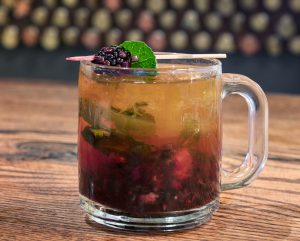
Russo is currently combining chai tea syrup with both whiskey and rum. She is using the chai syrup-rum combination as part of a vodka-based punch that adds a tropical twist, which balances out the heat of seasonal spices used. She has also used chamomile syrup for a winter take on the Pimms Cup, and she notes the summer variation was made with a hibiscus-rose tea. She also likes the way vanilla and Earl Grey flavors work into whiskey.
“Great things can come out of flavor combinations that don’t seem obvious right away,” she says.
Who knew the genteel-seeming world of tea could create such a dramatic impact on a cocktail menu? But then again, subtlety is one thing that defines some of the best cocktails out there.
By Elyse Glickman
Photos (top to bottom): Shutterstock/CheDima; Bar 54, Hyatt Centric Times Square, New York.


